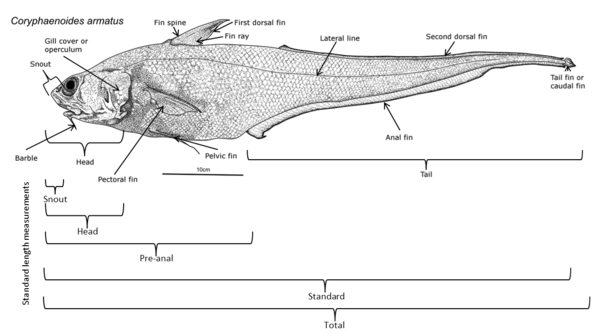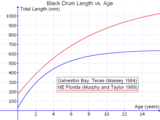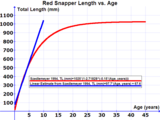Fish measurement is the measuring of individual fish and various parts of their anatomies, for data used in many areas of ichthyology, including taxonomy and fishery biology.
Overall length
[edit]Standard length (SL) is the length of a fish measured from the tip of the snout to the posterior end of the last vertebra or to the posterior end of the midlateral portion of the hypural plate. This measurement excludes the length of the caudal (tail) fin.[1]

Total length (TL) is the length of a fish measured from the tip of the snout to the tip of the longer lobe of the caudal fin, usually measured with the lobes compressed along the midline. It is a straight-line measure, not measured over the curve of the body.[2]
Standard length measurements are used with Teleostei (most bony fish), while total length measurements are used with Myxini (hagfish), Petromyzontiformes (lampreys) and usually Elasmobranchii (sharks and rays), as well as some other fishes.[2]
Total length measurements are used in slot limit and minimum landing size regulations.
Fishery biologists often use a third measure in fishes with forked tails, called Fork length (FL), the length of a fish measured from the tip of the snout to the end of the middle caudal fin rays, and is used in fishes in which it is difficult to tell where the vertebral column ends.[3]
Fin lengths and eye diameter
[edit]Other possible measurements include the lengths of various fins, the lengths of fin bases and the diameter of the eye.[4]

See also
[edit]References
[edit]- ^ "Term: standard length". FishBase.org. 2004-11-18. Retrieved 2015-08-18.
- ^ a b "Term: total length". FishBase.org. 2004-11-18. Retrieved 2015-08-18.
- ^ "Term: fork length". FishBase.org. 2004-11-18. Retrieved 2015-08-18.
- ^ "Standard Measurements of Bony Fish diagram". Florida Museum of Natural History Ichthyology Department. Retrieved 2007-06-06.
External links
[edit]- Diagram of fish measurements - Florida Museum of Natural History Ichthyology Department





Well, that’s interesting to know that Psilotum nudum are known as whisk ferns. Psilotum nudum is the commoner species of the two. While the P. flaccidum is a rare species and is found in the tropical islands. Both the species are usually epiphytic in habit and grow upon tree ferns. These species may also be terrestrial and grow in humus or in the crevices of the rocks.
View the detailed Guide of Psilotum nudum: Detailed Study Of Psilotum Nudum (Whisk Fern), Classification, Anatomy, Reproduction